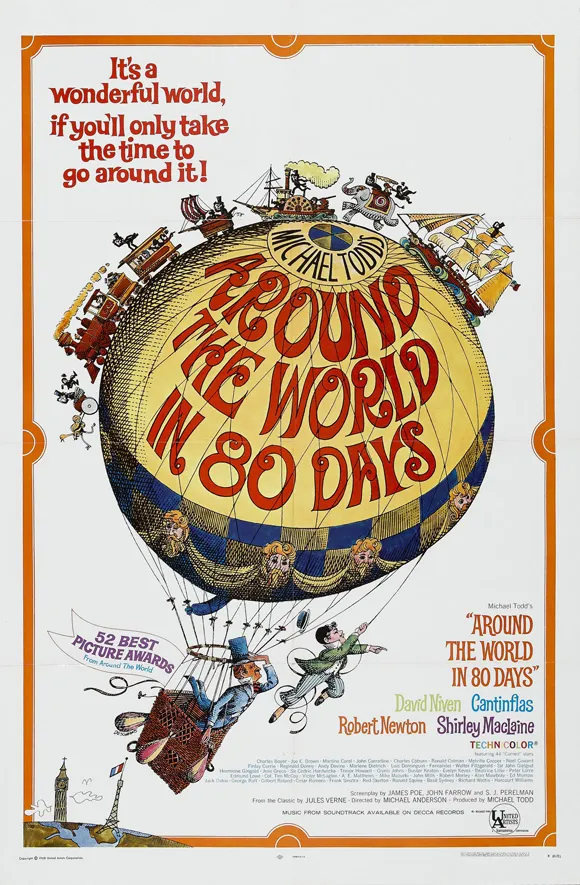
The 1956 film Around the World in 80 Days is an American epic adventure-comedy film based on the classic 1873 novel of the same name by Jules Verne. It stars David Niven, Cantinflas, Robert Newton, and Shirley MacLaine, and was directed by Michael Anderson and produced by Mike Todd.
The film was produced by the Michael Todd Company and released by United Artists. It has a running time of 182 minutes and was a box office success, grossing $42 million on a budget of $6 million. The movie won five Oscars, including Best Picture of 1956.
Plot
The plot of the 1956 film Around the World in 80 Days revolves around a Victorian Englishman named Phileas Fogg, who bets that he can circumnavigate the globe in 80 days. He sets off on this adventure with his loyal manservant, Passepartout, using the new steamships and railways.
Along the way, they encounter various challenges and adventures, including being pursued by a determined police Inspector who suspects Fogg of being a bank robber.
Trailer
@taskmaster4450le/re-leothreads-8lrhpf3p
Cast
- David Niven as Phileas Fogg
- Cantinflas as Passepartout
- Shirley MacLaine as Princess Aouda
- Robert Newton as Inspector Fix
- Finlay Currie as Andrew Stuart
- Robert Morley as Ralph, Bank of England Governor
- Ronald Squire as Reform Club member
- A. E. Matthews as Reform Club member
- Walter Fitzgerald as Reform Club member
- Glynis Johns as Sporting Lady
- Hermione Gingold as Sporting Lady
- John Mills as London carriage driver
- Beatrice Lillie as London revivalist leader
- Edward R. Murrow as the prologue narrator
- James Dime as a Londoner
Director: Michael Anderson
Writer: Jules Verne, James Poe, John Farrow
Distributor: Warner Home Vídeo, United Artists, Warner Bros.
Release Date (Theaters): Oct 17, 1956
Release Date (Streaming): Mar 29, 2017
Themes & Reception
The 1956 film Around the World in 80 Days has received generally positive reviews from critics. The film has been praised for its grand scale, star-studded cast, and cheerful, light-hearted entertainment. The movie won five Academy Awards, including Best Picture of 1956. The film has also been featured on Turner Classic Movies, showcasing its enduring appeal and popularity.
Some of the themes present in the film include:
- Adventure and exploration: The film captures the spirit of exploration and the desire to discover new places, as Phileas Fogg and his companions travel around the world, encountering various challenges and experiences along the way.
- Global connections: The story highlights the growing interconnectedness of the world in the late 19th century, as the characters navigate different cultures, languages, and societies during their journey.
- Class and social status: The film touches upon the social hierarchies of the time, as the characters interact with various classes of people and navigate the etiquette and expectations of their respective social positions.
- The power of technology: The use of modern inventions, such as steamships and railways, plays a significant role in the film, showcasing the transformative impact of technology on travel and communication.
Challenges Faced
The production of the 1956 film Around the World in 80 Days faced several challenges. One of the biggest challenges was the use of a new 70mm process, which posed extraordinary technical challenges, especially for a neophyte film producer, Michael Todd. The film was also a mega-production, with a budget of $6 million, and every dollar was visible onscreen to the tune of an extraordinarily bloated, dragging three hours.
Filming across several countries during a worldwide pandemic was another challenge faced by the production team of the 2021 TV adaptation of Around the World in 80 Days. After shooting just the first episode in early 2020, the cast and crew were forced to take almost a year-long hiatus. In the end, the shoot was spread across studios and onsite locations in South Africa and Romania over a five-month period.
Setting
The 1956 film Around the World in 80 Days is set in the late 19th century and follows the journey of Phileas Fogg and his companions as they travel around the world. The film features a variety of settings, including London, Paris, Spain, India, Hong Kong, Japan, and the United States.
The film's visual style is grand and lavish, reflecting the epic nature of the story, and incorporates various cinematic techniques to capture the diverse settings and cultures encountered during the characters' journey.
The film's use of elaborate set designs, colorful costumes, and innovative cinematography likely aimed to immerse the audience in the excitement and wonder of the characters' global expedition.
Trivia
- The film was produced by Michael Todd, who had been interested in the Verne novel since he briefly sponsored Orson Welles's 1946 theatrical production.
- The new 70mm process, which Todd used for the first time, posed extraordinary technical challenges, especially for a neophyte film producer
- The film set a new standard for the film industry by photographing on a larger film stock, doubling the 35mm width to 70mm.
- The film won five Oscars, including Best Picture of 1956.
- The film was shot in sequence over a five-month period, with the cast and crew traveling to various locations around the world, including London, Paris, Spain, India, Hong Kong, Japan, and the United States.
- The film's grand and lavish visual style aimed to immerse the audience in the excitement and wonder of the characters' global expedition.
- The film's use of elaborate set designs, colorful costumes, and innovative cinematography likely aimed to capture the diverse settings and cultures encountered during the characters' journey.
General:
Page by @iskafan